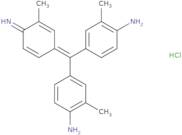New Fuchsin
CAS: 3248-91-7
Ref. 3D-DAA24891
| 10g | Descontinuado | ||
| 25g | Descontinuado | ||
| 50g | Descontinuado | ||
| 100g | Descontinuado | ||
| 250g | Descontinuado |
Informação sobre produto
- 4-[Bis(4-Amino-3-Methylphenyl)Methylidene]-2-Methylcyclohexa-2,5-Dien-1-Iminium Chloride
- Astra New Fuchsine G
- Astrazon Fuchsine GN
- Basic Violet 2
- Benzenamine, 4,4′-[(4-imino-3-methyl-2,5-cyclohexadien-1-ylidene)methylene]bis[2-methyl-, hydrochloride (1:1)
- Benzenamine, 4,4′-[(4-imino-3-methyl-2,5-cyclohexadien-1-ylidene)methylene]bis[2-methyl-, monohydrochloride
- Benzenamine, 4-[(4-amino-3-methylphenyl)(4-imino-3-methyl-2,5-cyclohexadien-1-ylidene)methyl]-2-methyl-, monohydrochloride
- Calcozine New Fuchsine
- Fuchsin NB
- Leather Ruby HF
- Ver mais sinónimos
- Magenta ABN
- Magenta III
- Neofuchsine
- New Fuchsine G Crystal
- New Magenta
- New fuchsine
- Remacryl Magenta B
Fuchsin is a water-soluble acidic dye that has been used as a histological stain for cell nuclei and to detect the presence of erythrocytes. Fuchsin stains are typically made by reacting fuchsine with potassium hydroxide, or by mixing fuchsin with other dyes such as methylene blue. The dye is readily absorbed by cells and stains cell nuclei red. Fuchsin can be detected using flow cytometry or electrochemical impedance spectroscopy. The dye binds to DNA in a manner similar to ethidium bromide and fluoresces at 510 nm when excited with ultraviolet light.
Fuchsin has been shown to inhibit the proliferation of epidermal growth factor (EGF) receptor-positive cells when exposed to radiation. This inhibition is due to an increase in reactive oxygen species (ROS). It has also been shown that fuchsin can react with DNA, forming covalent bonds between the aromatic rings of adjacent





